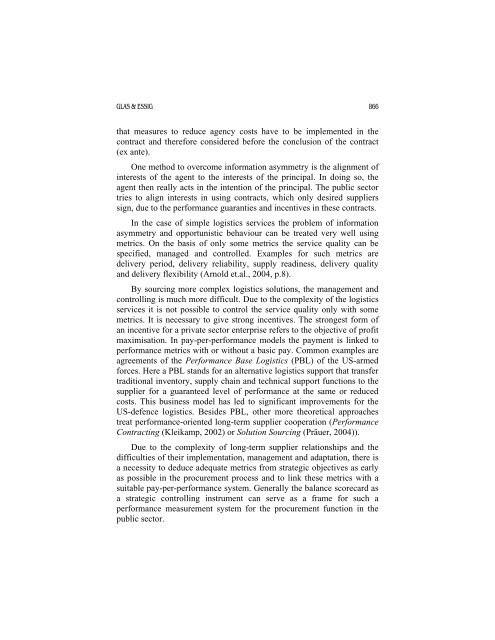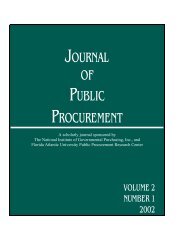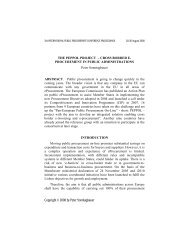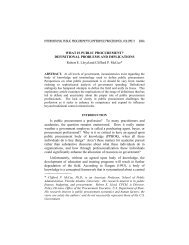Procurement of Integrated Logistics Services in the Public Sector
Procurement of Integrated Logistics Services in the Public Sector
Procurement of Integrated Logistics Services in the Public Sector
You also want an ePaper? Increase the reach of your titles
YUMPU automatically turns print PDFs into web optimized ePapers that Google loves.
GLAS & ESSIG 866that measures to reduce agency costs have to be implemented <strong>in</strong> <strong>the</strong>contract and <strong>the</strong>refore considered before <strong>the</strong> conclusion <strong>of</strong> <strong>the</strong> contract(ex ante).One method to overcome <strong>in</strong>formation asymmetry is <strong>the</strong> alignment <strong>of</strong><strong>in</strong>terests <strong>of</strong> <strong>the</strong> agent to <strong>the</strong> <strong>in</strong>terests <strong>of</strong> <strong>the</strong> pr<strong>in</strong>cipal. In do<strong>in</strong>g so, <strong>the</strong>agent <strong>the</strong>n really acts <strong>in</strong> <strong>the</strong> <strong>in</strong>tention <strong>of</strong> <strong>the</strong> pr<strong>in</strong>cipal. The public sectortries to align <strong>in</strong>terests <strong>in</strong> us<strong>in</strong>g contracts, which only desired supplierssign, due to <strong>the</strong> performance guaranties and <strong>in</strong>centives <strong>in</strong> <strong>the</strong>se contracts.In <strong>the</strong> case <strong>of</strong> simple logistics services <strong>the</strong> problem <strong>of</strong> <strong>in</strong>formationasymmetry and opportunistic behaviour can be treated very well us<strong>in</strong>gmetrics. On <strong>the</strong> basis <strong>of</strong> only some metrics <strong>the</strong> service quality can bespecified, managed and controlled. Examples for such metrics aredelivery period, delivery reliability, supply read<strong>in</strong>ess, delivery qualityand delivery flexibility (Arnold et.al., 2004, p.8).By sourc<strong>in</strong>g more complex logistics solutions, <strong>the</strong> management andcontroll<strong>in</strong>g is much more difficult. Due to <strong>the</strong> complexity <strong>of</strong> <strong>the</strong> logisticsservices it is not possible to control <strong>the</strong> service quality only with somemetrics. It is necessary to give strong <strong>in</strong>centives. The strongest form <strong>of</strong>an <strong>in</strong>centive for a private sector enterprise refers to <strong>the</strong> objective <strong>of</strong> pr<strong>of</strong>itmaximisation. In pay-per-performance models <strong>the</strong> payment is l<strong>in</strong>ked toperformance metrics with or without a basic pay. Common examples areagreements <strong>of</strong> <strong>the</strong> Performance Base <strong>Logistics</strong> (PBL) <strong>of</strong> <strong>the</strong> US-armedforces. Here a PBL stands for an alternative logistics support that transfertraditional <strong>in</strong>ventory, supply cha<strong>in</strong> and technical support functions to <strong>the</strong>supplier for a guaranteed level <strong>of</strong> performance at <strong>the</strong> same or reducedcosts. This bus<strong>in</strong>ess model has led to significant improvements for <strong>the</strong>US-defence logistics. Besides PBL, o<strong>the</strong>r more <strong>the</strong>oretical approachestreat performance-oriented long-term supplier cooperation (PerformanceContract<strong>in</strong>g (Kleikamp, 2002) or Solution Sourc<strong>in</strong>g (Präuer, 2004)).Due to <strong>the</strong> complexity <strong>of</strong> long-term supplier relationships and <strong>the</strong>difficulties <strong>of</strong> <strong>the</strong>ir implementation, management and adaptation, <strong>the</strong>re isa necessity to deduce adequate metrics from strategic objectives as earlyas possible <strong>in</strong> <strong>the</strong> procurement process and to l<strong>in</strong>k <strong>the</strong>se metrics with asuitable pay-per-performance system. Generally <strong>the</strong> balance scorecard asa strategic controll<strong>in</strong>g <strong>in</strong>strument can serve as a frame for such aperformance measurement system for <strong>the</strong> procurement function <strong>in</strong> <strong>the</strong>public sector.















